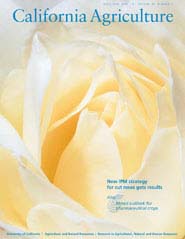


University of California
California Agriculture



|
|||
|
|||

New IPM Strategy for cut roses gets results
Cover:
A new IPM program for cut roses succeeded in controlling twospotted spider mites and reducing pesticide use. Photo: Jack Kelly Clark
April-June 2007
Volume 61, Number 2 News and opinionGeneral Information |
|||
|
University of California, 1301 S. 46th St., Bldg. 478 Richmond, CA
|